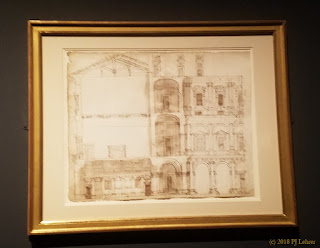The Michelangelo exhibit at the Met closed on Monday. Hopefully you got a chance to see it before
it did.
It was billed as a "once-in-a-lifetime"
exhibition, which it was. That's
partially because it was so deep - 133 drawings.
But also because the drawings are so fragile that the show
will not be traveling to other locations as they usually do once an exhibit it
put together.
In fact, usually the other museums that donated to the show
get the exhibit next. In this case there
was a long list of mostly private donors.
And a bunch of the drawings were on loan from Queen
Elizabeth.
This rather bizarre painting - the only painting by
Michelangelo in the show, is from the Kimbel in Dallas. I wonder what the Met promised in return.
The exhibit was crowded of course, even on an weekday in February. But that didn't stop some
people from attempting to sketch. This
was my favorite drawing of the collection - M's lover!
My favorite room of the show was the one where they
displayed pieces that related to the famous Sistine Chapel.
This one is from the Met's collection - note that he drew a
man and then turned it into a woman.
That is fairly typical of M.
Women were not his strength. Nor was drawing for that matter. He was first and foremost a divine
sculptor.
And most of his drawings that I have seen are fragments
designed to help him work out specific details for his paintings and sculptures.
This drawing of god's hand was the highlight of the exhibit
for me. I could be wrong. But the way I see it, he started with the
idea on the bottom. But after sketching
it out had a different thought. So he
did the top sketch - which he did not finish - because he didn't need to once
he saw that it was working. Awesome.
What made me want to see the exhibit in the first place was
that it included a cartoon. A cartoon is
a full size drawing that is used to transfer the final design to the
plaster. After the drawing is complete,
small pin marks are made on the outlines.
Then charcoal is brushed over them to transfer the design. If you went close enough you could see the
pin holes.
You can also see that this isn't one figure. The other part of transferring designs to
large spaces is that you make a grid on the smaller piece and then enlarge each
square. Again you can actually see the
squares. Mind bogging. The only other cartoon I have seen was at The
National Gallery in London. That one was
of a single figure. It's amazing that
either has survived.
Cheers!
PJ
(c)
2018 PJ Lehrer














No comments:
Post a Comment